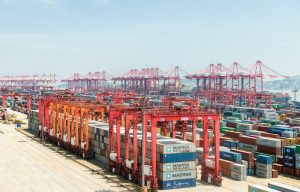 Severe port congestion that Shanghai has been suffering since the beginning of April, eased slightly by the end of the month, however may last till late May, as carriers and forwarders warn their customers. During the week of April 16 to 22, the average vessel arrival delay decreased from 53.1 hours to 51.2 hours and the number of vessels waiting outside Shanghai is down to around 80 from 100 vessels the previous week. However, the congestion now has also spread to other major Chinese ports, such as Ningbo and Qingdao.
Severe port congestion that Shanghai has been suffering since the beginning of April, eased slightly by the end of the month, however may last till late May, as carriers and forwarders warn their customers. During the week of April 16 to 22, the average vessel arrival delay decreased from 53.1 hours to 51.2 hours and the number of vessels waiting outside Shanghai is down to around 80 from 100 vessels the previous week. However, the congestion now has also spread to other major Chinese ports, such as Ningbo and Qingdao.
Examining the reasons for the situation, analysts name bad weather conditions, such as dense fog, and the new shipping alliances structure that came into effect on April 01, leading to extensive port calls rescheduling in April and May and “imbalanced business volumes from major container shipping routes”, as expressed by Shanghai International Port Group (SIPG).
Another factor, highlighted by Drewry Shipping Consultants, is that the Chinese ports are struggling under the weight of extra business. In their Container Insight Weekly published April 30, Drewry examine China’s top 10 ports’ throughput and note that the ports facing the worst of the congestion registered the biggest volume growth in the first quarter of 2017: Qingdao (12%), Shanghai (10%) and Ningbo (9%).
This significantly increased traffic suggests that not only heavy fog and vessel re-shuffling have caused the congestion, that “something else is at play”.
And indeed, Drewry’s report continues, an examination of recent trade statistics confirms that the long-discussed efforts of China’s government to rebalance the nation towards a more consumer-driven import economy seem to have borne their fruit. Between 2012 and 2016, Greater China’s container imports from Europe, the US, Middle East and South Asia grew by just 0.1% per year, and exports to the same markets registered CAGR of 3.8%. However, in 2016 imports to Greater China outpaced exports: the inbound trade from the above outlined markets growing by 2.3% y-o-y versus 0.5% for the outbound market, with the transition gathering pace since August of last year.
This finding drives an interesting conclusion. Having been an export driven economy for so long, China’s ports have not had to deal with long dwell times in terminal yards as boxes tend to be swiftly loaded onto ships for export. However, the current intake of imports could well be putting pressure on yards, so far unseen in China and consequently not yet adapted to. This may mean a longer-term trend that unless remedied by more capacity (to both terminals and yards) will continue to put pressure on ports that are already close, if not beyond, their realistic maximum utilisation levels.
